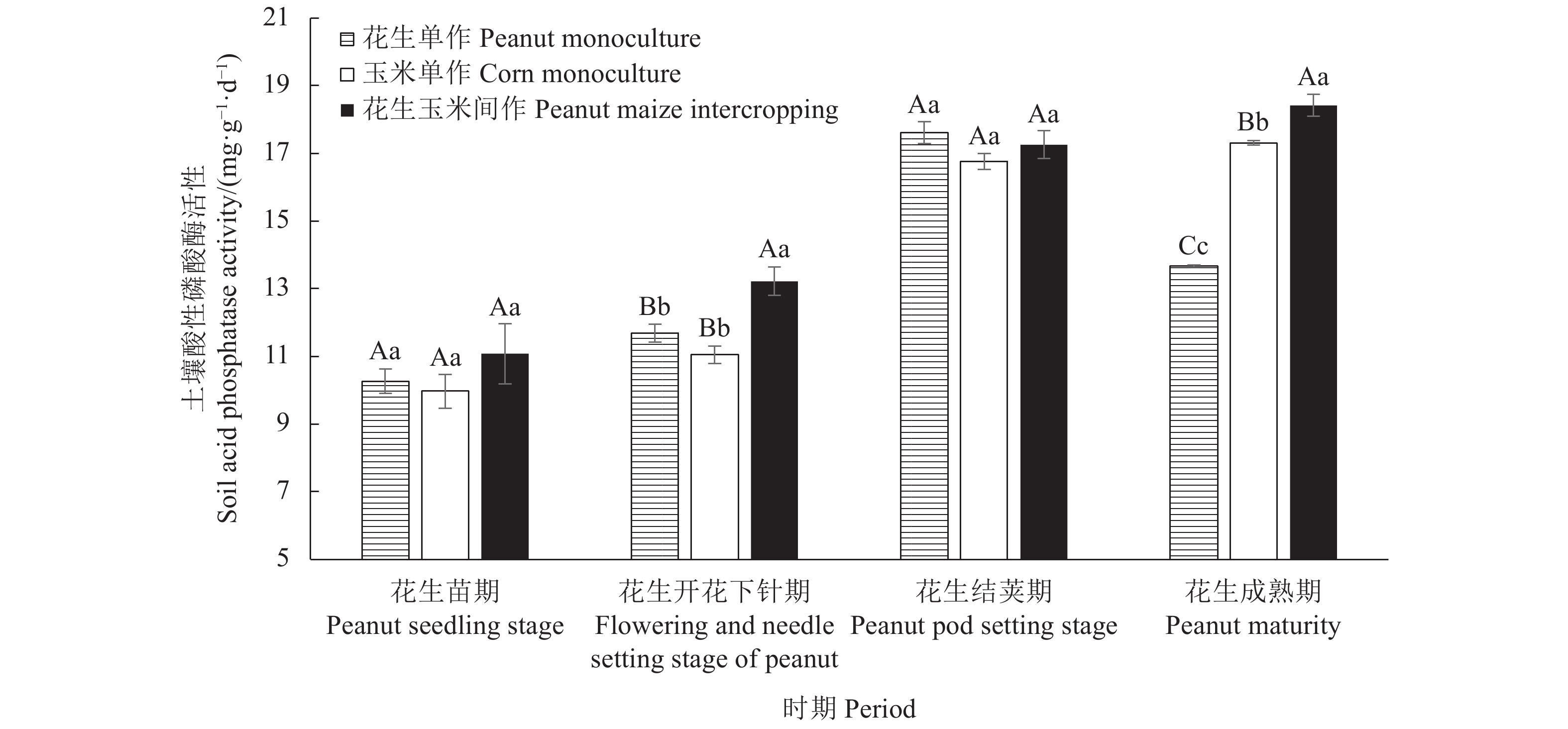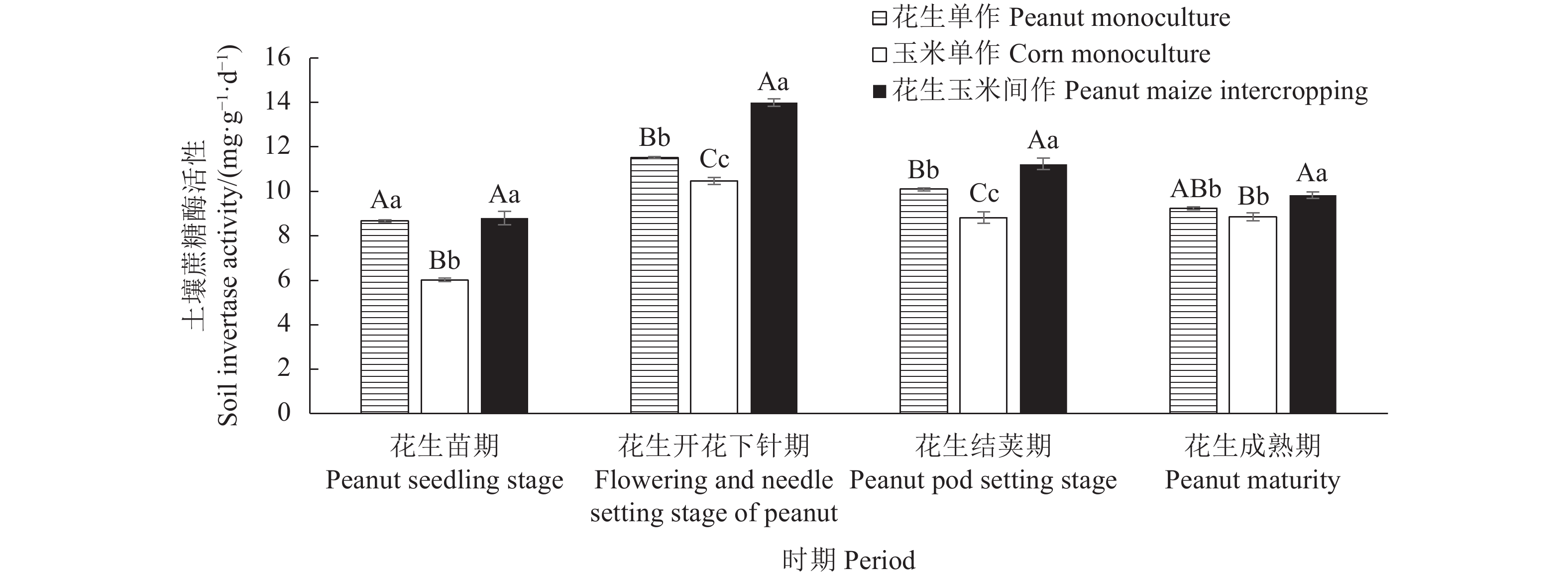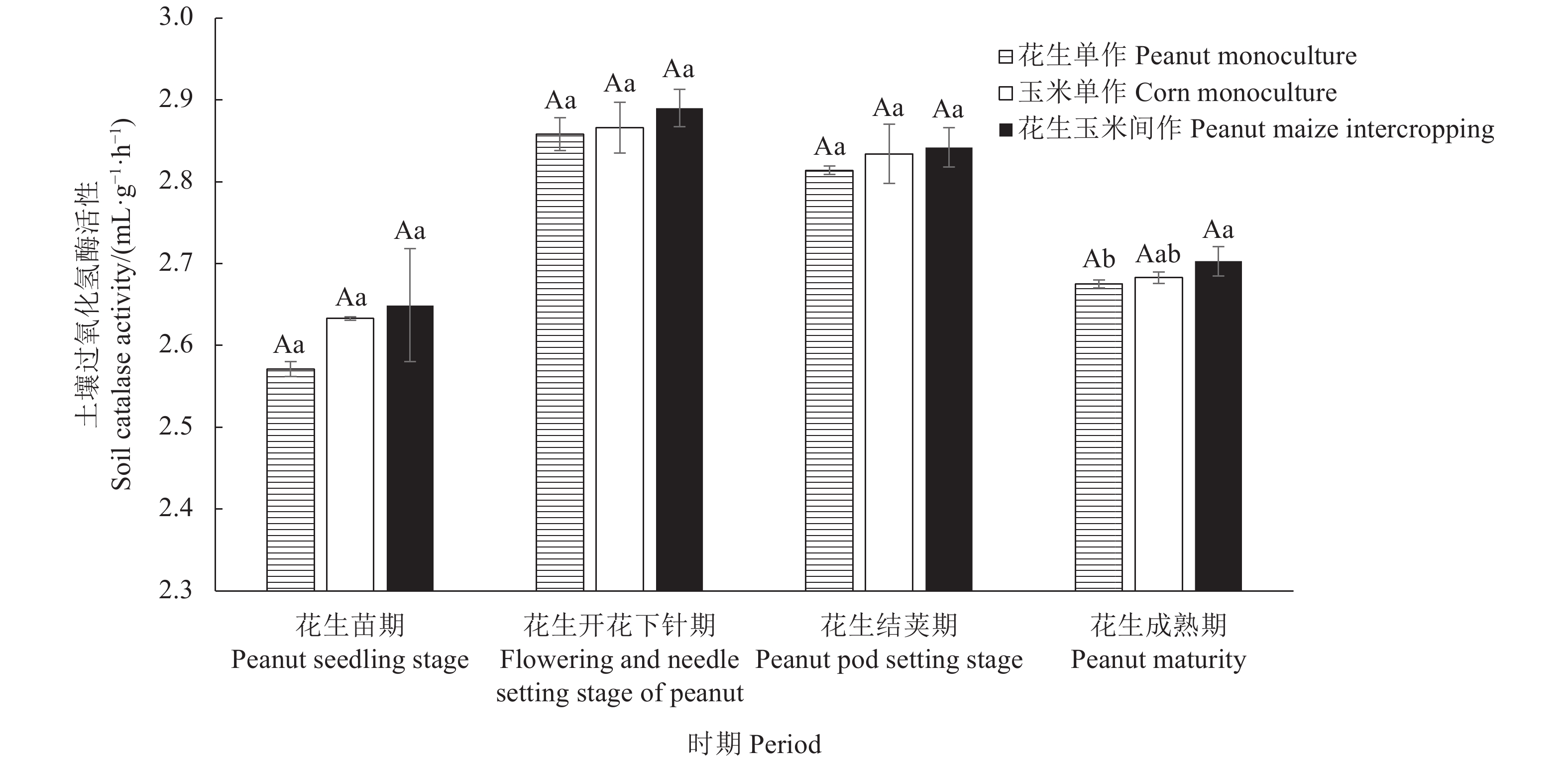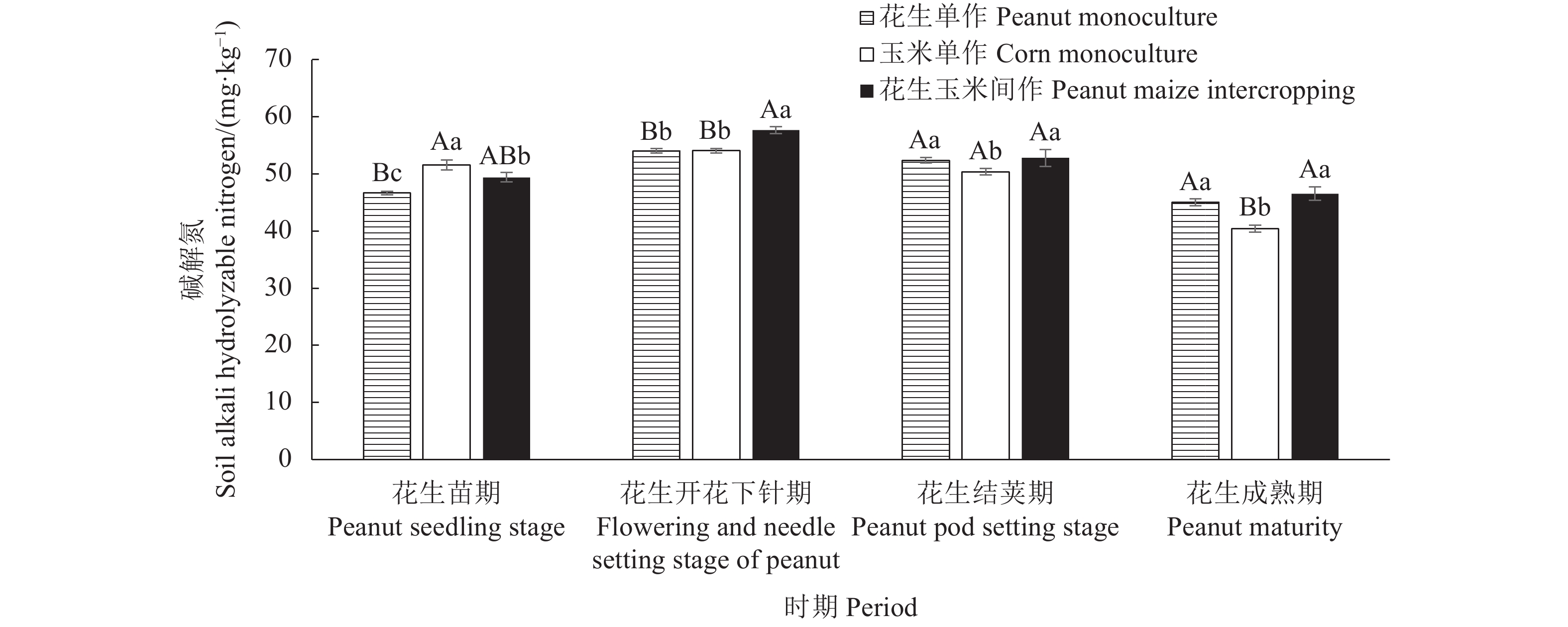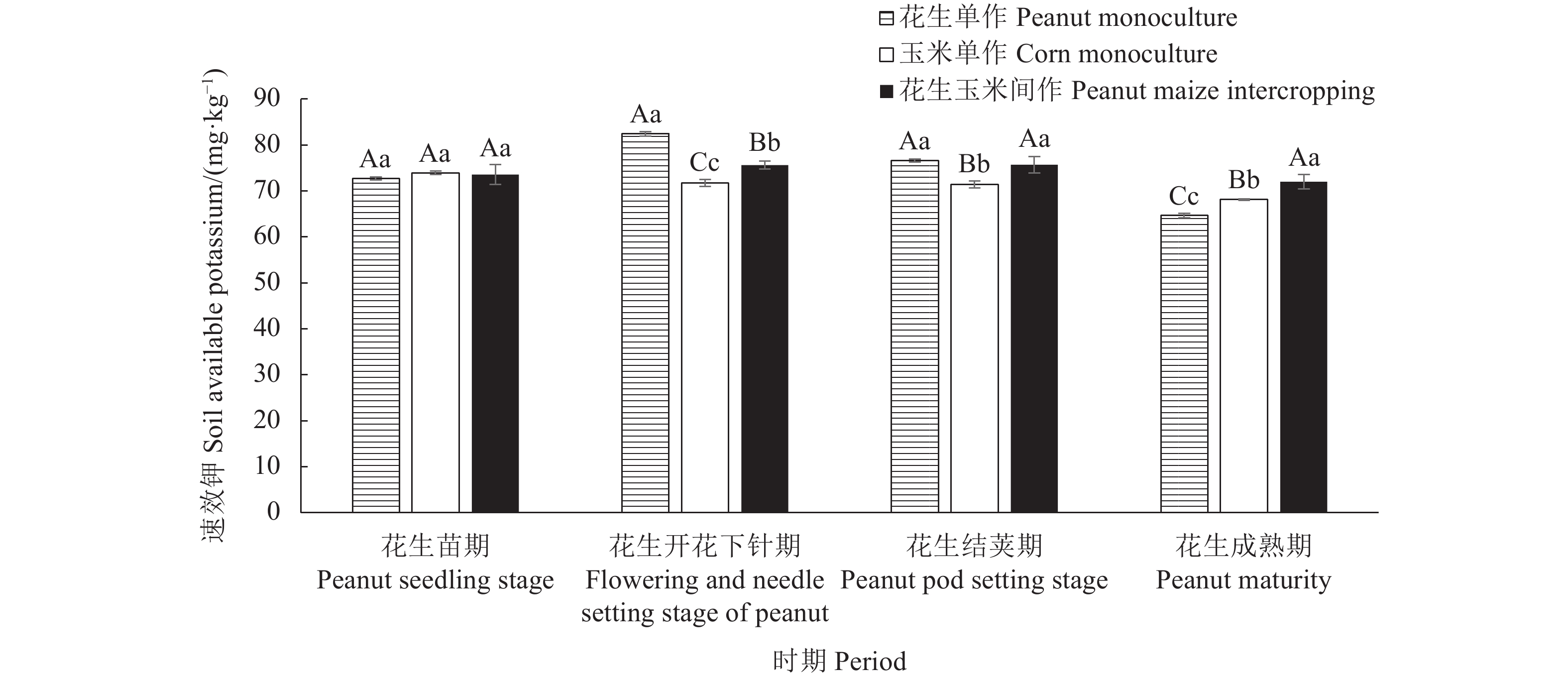Crop Yield, Rhizosphere Enzyme Activity, and Soil Fertility as Affected by Peanut/Maize Intercropping
-
摘要:目的 研究花生玉米间作对土壤酶活性、养分及作物产量的影响。方法 采用大田试验的方法,以泉花557及雪甜7401为材料,在不同生育时期,测定花生单作、玉米单作和花生玉米间作根际土壤养分含量和酶活性的变化规律,并进行相关性分析。结果 (1)在花生开花下针期和结荚期,花生玉米间作处理作物根际土壤脲酶活性分别比花生单作提高4.7%和5.0%,分别比玉米单作提高了2.6%和4.3%。(2)在花生苗期、开花下针期及花生成熟期,间作处理作物根际土壤酸性磷酸酶活性分别比花生单作提高8.0%、13.0%和34.7%,分别比玉米单作提高11.1%、19.6%和6.4%。(3)在花生苗期、开花下针期、结荚期及花生成熟期,花生玉米间作处理作物根际土壤蔗糖酶活性分别比花生单作提高1.5%、21.5%、11.2%和6.4%,分别比玉米单作提高了46.4%、33.8%、27.3%和11.1%。(4)在花生成熟期时,间作根区土壤的碱解氮和速效钾含量分别比玉米单作提高15.11%和5.66%,碱解氮、有效磷和速效钾含量分别比花生单作提高了3.42%、13.17%和11.39%。(5)相关性分析结果表明,在花生开花下针期,碱解氮与酸性磷酸酶、蔗糖酶存在显著正相关关系(P<0.05),有效磷与酸性磷酸酶、蔗糖酶存在显著正相关关系(P<0.05);在花生结荚期,碱解氮与蔗糖酶存在显著正相关关系(P<0.05);速效钾与酸性磷酸酶存在显著正相关关系(P<0.05);在花生成熟期,速效钾与过氧化氢酶存在显著正相关关系(P<0.05)。(6)花生玉米间作的经济收益为48 217.50 元·hm−2,分别比花生单作和玉米单作的收益增加8 842.50 元·hm−2和3 157.50 元·hm−2。结论 花生玉米间作可以改善两种作物根际土壤酶活性和养分状况,并能提高经济效益。Abstract:Objective Effects of peanut/maize intercropping on crop yield, rhizosphere enzyme activity, and nutrients in soil were studied.Method In a field experiment, Quanhua 557 peanut and Xuetian 7401 maize plants were cultivated either separately or under intercropping. The resulting crop yields as well as the nutrient content and enzyme activity in the rhizosphere soils were monitored at different growth stages of peanut monoculture, maize monoculture and peanut/maize intercropping for a correlation analysis.Result (1) In comparison with monoculture, peanut intercropped with maize raised the rhizosphere urease activity by 4.7% at peanut flowering stage, and by 5.0% at pod setting stage. For maize, the increases at the stages were 2.6% and 4.3%, respectively. (2) During seedling, flowering/needle setting, and maturation of the peanut plants, the acid phosphatase activities in soil were 8.0%, 13.0%, and 34.7%, respectively, higher under intercropping than monoculture. For maize, the activities rose by 11.1%, 19.6%, and 6.4%, respectively. (3) In the seedling, flowering/needle setting, pod setting, and maturation of peanut plants, the invertase activity in soil increased 1.5%, 21.5%, 11.2%, and 6.4%, respectively, by the intercropping. In those stages of maize plants, the increases were 46.4%, 33.8%, 27.3%, and 11.1%, respectively. (4) At peanut maturation, the contents of alkali hydrolyzable nitrogen and available potassium in the intercropped rhizosphere soil were 15.11% and 5.66%, respectively, higher than those of maize monoculture, while the contents of alkali hydrolyzable nitrogen, available phosphorus, and available potassium 3.42%, 13.17%, and 11.39%, respectively, higher than those of monoculture. (5) A significant correlation existed between the alkali hydrolyzable nitrogen and the activities of acid phosphatase and sucrase, as well as between the available phosphorus and the activities of acid phosphatase and sucrase, in soil when the peanut plants were flowering and needle setting (P<0.05). At the pod setting stage, it was one between the alkali hydrolyzable nitrogen and the invertase activity (P<0.05), and another between the available potassium and the acid phosphatase (P<0.05). At maturity of peanut, available potassium in the rhizosphere soil correlated significantly with catalase activity (P<0.05). (6) The intercropping generated 48 217.50 yuan·hm−2 in revenue, which was 8 842.50 yuan·hm−2 more than the peanut monoculture or 3 157.50 yuan·hm−2 more than the maize monoculture.Conclusion The peanut/maize intercropping significantly increased the enzyme activity and nutrient contents in the rhizosphere soil as well as the economic return over monoculture of either crop.
-
Keywords:
- Peanuts /
- maize /
- intercropping /
- enzyme activity /
- nutrient
-
光合作用是作物产量的根本来源,作物的干物质的积累,有90%左右的物质来自作物光合作用的产物。水稻产量的形成有80%是来自光合产物的积累,因此,对不同水稻种质光合特性的分类、评价及深入了解,挖掘水稻高光效种质资源,对水稻高产育种及种质资源改良起到一定的推动作用。作物种质资源光合特性研究[1-3]前人在水稻、大麦、甘蔗等都做了一定的研究。赵明等[4]研究表明利用稻属的高光效资源也是改进水稻光合作用的一条重要途径。赵秀琴等[5]研究热带地区筛选出的不同高光效水稻材料在温带地区也有稳定的遗传差异。曹树青等[6]研究了水稻种质资源光合速率及光合功能期,筛选出一些具有特异光合性状的典型材料,可用于水稻育种改良及优化配组。刘怀年等[7]研究117份水稻种质资源表明始穗期至齐穗期的光合速率可代表其光合速率。本研究以58份来自于不同国家和地区的水稻种质资源为材料,对其始穗期光合特性进行研究,并通过聚类分析,从不同背景的稻种资源中筛选出高光合速率及高水分利用效率等水稻种质资源,以期为水稻高产育种、耐旱育种的遗传改良提供参考。
1. 材料与方法
1.1 试验材料
供试材料为来自不同国家和地区的58份水稻种质资源,编号为A1~A58(表 1)。
表 1 58份供试水稻种质资源Table 1. Fifty-eight rice germplasms studied代码 品种名称 A1 嘉南8号 A2 嘉南9号 A3 明恢72 A4 02428 A5 92gk729 A6 97gk419 A7 97gk1019 A8 97gk1037 A9 98gk2046 A10 20gk719 A11 47粳 A12 华明921 A13 明恢63 A14 WJ413 A15 多系一号 A16 亚恢420 A17 明恢86 A18 R527 A19 MHR18 A20 超引一号 A21 9308 A22 C418 A23 圭630 A24 康丰B A25 科恢752 A26 明恢398 A27 明恢413 A28 明恢416 A29 明恢417 A30 明恢419 A31 明恢436 A32 明恢3009 A33 明恢502 A34 明恢503 A35 明恢504 A36 明恢506 A37 明恢507 A38 明恢508 A39 明恢509 A40 明恢510 A41 明恢511 A42 明恢512 A43 明恢513 A44 明恢514 A45 明恢515 A46 明恢516 A47 明恢517 A48 明恢518 A49 明恢519 A50 明恢522 A51 明恢523 A52 明恢524 A53 明恢527 A54 明恢530 A55 明恢532 A56 明恢533 A57 明恢534 A58 明恢118 1.2 试验方法
试验在莆田试验基地进行,采用随机区组设计,3次重复,每份材料种植5行,每行8株,单本种植,种植规格20 cm×20 cm,常规管理。
1.3 测定项目及方法
利用便携式光合作用测量系统 (LI-6400XT) 测定供试水稻种质资源光合特性相关指标:Pn、E、C和WUE等。测定方法:在始穗期选晴天9:00~11:00,测定剑叶中上部,设定光强为1 200 μmol·m-2·s-1、温度为30~33℃,CO2体积分数为330 μL·L-1,每株测定3个重复。采用日产SPAD-502叶绿素测定仪对相同叶片进行SPAD值测定。测定方法:在待测叶中部及距离中部上下约3 cm处各测1次 (避开叶片中脉),取3次平均值作为该叶片的SPAD测定值,通过SPAD值评估当前叶片中的叶绿素相对含量。通过聚类分析,对所测得Pn、WUE和SPAD值进行分类,筛选并确定相应高优种质资源。
1.4 统计分析
试验数据在Excel电子表格上进行,相关性分析、主成分分析在SPSS13.0上进行,方差分析、聚类分析在DPS7.05上进行。
2. 结果与分析
2.1 不同种质资源间光合指标的差异
对58份水稻种质资源的光合特性指标、WUE及SPAD进行测定,并对测定结果进行方差分析,结果 (表 2) 表明,供试水稻种质资源间Pn、E、C差异达到极显著水平 (P < 0.01),WUE差异达显著水平,SPAD差异达极显著水平。其中,Pn值最高的水稻资源为明恢419,CO2达56.87 μmol·m-2·s-1,Pn值最低的品种资源为98gk2046,CO2仅20.13 μmol·m-2·s-1,Pn值最高与最低相差2.83倍,变异系数 (CV) 为24.43。C平均值H2O为0.66 mmol·m-2·s-1,H2O变幅为0.53~0.78 mmol·m-2·s-1,变异系数CV为10.45;E平均值H2O为4.90 mmol·m-2·s-1,H2O变幅为1.07~8.50 mmol·m-2·s-1,CV为37.91;WUE平均值CO2为3.25 μmol·mmol-1 H2O,CO2变幅为1.50~5.90 μmol·mmol-1 H2O,CV为29.6。SPAD平均值为44.43,变幅为36.50~53.97,CV为6.64。
表 2 58份水稻种质资源光合特性、WUE和SPAD品种间差异Table 2. Variances on PC, WUE and SPAD among 58 rice germplasms项目 变异来源 自由度 平方和 均方 F值 平均值 Pn 品种间 57 13631.5522 239.15 2.533** 36.55±8.93 误差 114 10761.5521 94.3996 总变异 173 24441.972 C 品种间 57 0.8055 0.0141 5.709** 0.66±0.07 误差 114 0.2822 0.0025 总变异 173 1.0938 E 品种间 57 612.8281 10.7514 5.128** 4.90±1.86 误差 114 238.9983 2.0965 总变异 173 859.0748 WUE 品种间 57 162.7499 2.8553 1.543* 3.25±0.96 误差 114 211.0164 1.851 总变异 173 375.2699 SPAD 品种间 57 1489.5853 26.1331 7.318** 44.43±2.95 误差 114 407.1154 3.5712 总变异 173 1904.5919 注:*表示差异达显著水平 (P < 0.05),**表示差异达极显著水平 (P < 0.01)。 2.2 主要光合性状的聚类分析
采用系统聚类法,选择Pn、SPAD和WUE 3个指标,以欧氏距离作为统计量,用类平均法对58个水稻资源进行聚类分析。聚类结果 (表 3) 显示,当欧氏距离为1.82时,可将其分为7个类群。1类群有3份种质资源,为极高Pn、高SPAD并且WUE极高型;2类群有2份种质资源,为低Pn、低SPAD并且WUE极低型;3类群有5份种质资源,表现为低Pn,高SPAD,WUE中等型;4类群有3份种质资源,为高Pn、高SPAD、WUE中等型;5类群有16份种质资源,为低Pn、SPAD中等,低WUE型;6类群有6份种质资源,为高Pn、高WUE,SPAD中等型;7类群有23份种质资源,表现为Pn、SPAD中等,WUE较高型。
表 3 58份水稻种质资源Pn、SPAD及WUE的聚类分析结果Table 3. Classification of rice germplasms based ontheir Pn, SPAD and WUE类群 品种代号 个数 频率/% 类平均 变幅 Pn SPAD WUE Pn SPAD WUE 1 A19、A30、A54 3 5.17 52.56±4.17 48.07±0.15 5.22±0.63 48.53~56.87 47.9~48.20 4.67~5.90 2 A9、A48 2 3.45 21.3±1.65 37.95±2.05 1.87±0.52 20.13~22.47 36.5~39.40 1.5~2.23 3 A4、A20、A47、A49、A21 5 8.62 30.51±1.92 49.99±2.32 2.89±0.29 28.6~33.67 48.00~53.97 2.43~3.20 4 A13、A31、A32 3 5.17 50±2.06 47.39±1.72 2.86±0.46 47.63~51.40 45.5~48.87 2.47~3.37 5 A6、A51、A41、A45、A27、A42、A34、A39、A52、A57、A44、A17、A35、A58、A38、A53 16 27.59 29.84±5.33 43.97±1.78 2.26±0.44 23.4~40.83 40.8~47.17 1.57~3.03 6 A8、A29、A55、A43、A28、A33 6 10.43 49.63±3.45 43.68±0.87 4.41±0.49 44.6~54.77 42.6~44.93 3.6~4.87 7 A1、A18、A46、A14、A26、A25、A7、A12、A36、A37、A16、A23、A24、A40、A2、A15、A56、A11、A3、A22、A50、A5、A10 23 39.66 36.61±3.63 43.43±1.90 3.64±0.37 27.43~44.03 40.23~46.17 2.93~4.43 注:表中Pn的CO2单位为μmol·m-2·s-1;WUE的CO2单位为μmol ·mmol-2H2O。 2.3 光合速率与叶绿素相对含量
第1、4、6类群均为高Pn型种质资源,包含97gk1037、明恢417、明恢3009、明恢436、MHR18、明恢63、明恢416、明恢530、明恢532、明恢513、明恢419、明恢502等12份种质资源,测定其SPAD值在42.6~48.87,均值45.7,高于58份种质资源的SPAD均值44.43。其中,明恢419 Pn值最高,CO2为56.87 μmol·m-2·s-1,其SPAD值为47.90,也高于1、4、6类群种质资源的SPAD均值;98gk2046 Pn值在所有种质资源中最低,CO2为20.13 μmol·m-2·s-1,其SPAD也最低为36.50;而SPAD值最高的为种质资源9308,其Pn值CO2为30.10 μmol·m-2·s-1,低于Pn平均值,因此可以看出SPAD对供试材料Pn有一定影响,但其大小不能决定Pn的高低。
2.4 光合速率与水分利用效率
WUE是反映植物耐旱性的一个有效指标,也是显示植物有效利用水分的能力,即在相同条件下,WUE高的植物抗旱能力强。从表 3聚类结果可以看出,第1类群WUE极高型,其CO2值为5.22 μmol·mmol-1 H2O,Pn值CO2为52.56 μmol·m-2·s-1;第6类群WUE较高型,其CO2值为4.41 μmol·mmol-1 H2O,Pn值CO2为49.63 μmol·m-2·s-1;第7类群也是WUE较高型的水稻种质资源,其CO2值为3.64 μmol·mmol-1 H2O,Pn值CO2为36.61 μmol·m-2·s-1。可以看出第1、6、7类群可作为耐旱型水稻种质资源,进行杂交配组选育相关耐旱品种,特别是第1类群极高水分利用效率种质资源,甚至直接可作为耐旱亲本杂交配组使用。从光合速率来看,第1、6类群光合速率都大于供试种质资源平均光合速率,因此,其也可以作为高光合速率水稻种质资源中间材料或配组亲本使用。
2.5 光合性状间的相关分析与主成分分析
从表 4可以看出,Pn与E、WUE呈极显著正相关;C与WUE呈极显著负相关,与E呈极显著正相关。主成分分析 (表 5) 表明,前3个主成分 (PRIN1、PRIN2、PRIN3) 的方差累计贡献率达95.31%。第1主成分占总方差的42.58%,C、Pn对PRIN1有较强的正向负荷,E对PRIN1有较强的逆向负荷;第2主成分占总方差的34.04%,主要由WUE和Pn构成,有较大的正向负荷;第3主成分占总方差的18.70%,主要由SPAD构成,有较大的正向负荷。
表 4 光合性状、WUE和SPAD间的相关系数Table 4. Correlation coefficients among PC, WUE and SPAD性状 Pn C E WUE SPAD Pn 1.000 C -0.246 1.000 E 0.640** 0.340** 1.000 WUE 0.347** -0.925** -0.220 1.000 SPAD 0.202 -0.056 0.087 0.074 1.000 注:*、**分别表示在0.05和0.01水平 (双侧) 上显著相关。 表 5 特征向量和特征根Table 5. Eigenvectors and eigen values性状 主成分 PRIN1 PRIN2 PRIN3 Pn 0.405 0.855 -0.163 C 0.974 -0.034 -0.085 E -0.966 0.158 0.056 WUE -0.239 0.909 -0.208 SPAD 0.165 0.343 0.924 特征根 2.129 1.702 0.935 贡献率/% 42.578 34.039 18.694 累计贡献率/% 42.578 76.617 95.310 3. 讨论与结论
光合作用是植物生长和物质积累的基础。翟虎渠等[8]研究认为水稻灌浆后期叶片仍能保持较高效光合功能,并且能够切合籽粒灌浆需求对水稻超高产至关重要。张建福等[9]研究表明再生稻灌浆期的净光合速率与产量呈极显著正相关,与结实率呈显著正相关。韩勇等[10]分析表明,水稻产量随着叶片Pn的增加而提高,二者呈显著的幂指函数关系。可见Pn提高是水稻增产的重要途径之一。WUE是对植物性能的一种测量[11],在农作物系统中,提高水分利用效率是面对有限用水供给时增加农作物产量的有效方法。目前研究水分对稻类光合作用的影响,主要集中在水分胁迫方面。张秋平等[12]研究发现旱稻前期胁迫后期充分灌水的处理产量水平的水分利用效率最高。何海兵等[13]对水稻在不同栽培模式下水分利用效率的研究结果表明膜下滴灌栽培的水分利用效率高于常规淹灌栽培、覆膜沟灌及沟灌等栽培模式。邵玺文等[14]研究指出水稻在拔节孕穗其期受到水分胁迫严重,单位面积有效穗数、穗粒数甚至千粒重低都将大幅降低,孕穗期受水分胁迫产量对照低63.8%。因此,高WUE种质资源可以看成是稻类在淹水、湿润甚至半干旱环境里能够良好地生长并生产的一个极其重要的特征。刘怀年等[15]对水稻Pn与农艺性状的关系进行研究,得出高光合速率的资源具有叶色绿或深绿等特点,张宗琼等[16]研究结果表明,水稻SPAD值仅可从侧面反应与光合速率具有相关性,并不能决定光合速率的高低。孟卫卫等[17]研究发现高叶绿素含量水稻品种,其Pn也较高。孟军等[18]研究得出在高光强条件下,叶绿素含量在一定范围内与剑叶净光合速率呈正相关。可见,水稻生长在田间开放的系统中,受外界环境因素如光照、水分等胁迫影响。所以试图通过控制大田环境条件来提高光合速率、减少碳同化的损失在目前是不现实的,也是人们对稻类等作物生产成本所不允许的。但通过选育高光合速率、抗逆性好的品种,筛选高光效种质资源加以利用,提高稻类等作物产量是可行的。因此,高光效育种[19]是目前育种学家共同关注的研究领域,但高光效育种不只是高光合速率植株的筛选,而应该是综合光合生理性能的筛选,本研究以Pn、SPAD和WUE3个指标进行综合聚类,将58个种质资源分为7个类群,其中1、6类群的9个种质资源MHR18、明恢419、明恢530、97gk1037、明恢417、明恢532、明恢513、明恢416、明恢502综合光合性能好,Pn均值CO2为51.09 μmol·m-2·s-1,WUE均值CO2为4.82 μmol·mmol-1 H2O,共9份,占供试材料的15.5%,可以作为高光效育种水稻种质资源的改良亲本或水稻高产育种、抗逆育种的配组亲本。
-
图 2 不同时期花生玉米间作对土壤脲酶活性影响
注:大写字母不同表示差异极显著(P<0.01),小写字母不同表示差异显著(P<0.05)。显著性分析为按各时期分析,下图同。
Figure 2. Effect of peanut/maize intercropping at different stages of plant growth on soil urease activity
Note: Different capital letters mean significant difference (P<0.01), and different lowercase letters mean significant difference (P<0.05). The significance analysis is based on the same period, and the following fig is the same.
表 1 不同时期土壤养分与酶活性的相关性分析
Table 1 Correlation between soil nutrients and enzyme activities at different stages of plant growth
时期
Stage项目
Item脲酶
Soil urease activity酸性磷酸酶
Soil acid phosphataseactivity蔗糖酶
Soil invertase activity过氧化氢酶
Soil catalase activity花生苗期
Peanut seedling stage碱解氮
Alkali hydrolyzable nitrogen−0.825 −0.176 −0.801 0.809 有效磷
Available phosphorus0.932 0.913 0.946 0.031 速效钾
Available potassium−0.731 0.027 −0.702 0.888 花生开花下针期
Flowering and needle
setting stage of peanut碱解氮
Alkali hydrolyzable nitrogen0.907 0.956* 0.954* 0.947 有效磷
Available phosphorus0.852 0.984* 0.983* 0.903 速效钾
Available potassium−0.562 0.135 0.140 −0.469 花生结荚期
Peanut pod setting stage碱解氮
Alkali hydrolyzable nitrogen0.546 0.826 0.952* −0.133 有效磷
Available phosphorus0.529 0.837 0.946 −0.153 速效钾
Available potassium0.232 0.968* 0.794 −0.459 花生成熟期
Peanut maturity碱解氮
Alkali hydrolyzable nitrogen−0.884 −0.054 0.923 0.454 有效磷
Available phosphorus0.835 0.901 −0.105 0.563 速效钾
Available potassium0.212 0.947 0.621 0.980* *为P<0.05,**为P<0.01。
*means P<0.05; **means P<0.01.表 2 花生玉米间作对产量及经济效益的影响
Table 2 Effects of peanut/maize intercropping on crop yield and economic benefits
处理
Treatment产量
Yield/(kg·hm−2)单价
Unit Price/(Yuan·kg-1)效益
Benefit/(元·hm−2)单作花生(泉花557) Peanutmonoculture (Quanhua 557) 3937.50 10.00 39375.00 单作玉米(雪甜7401) Corn monoculture (Xuetian 7401) 9012.00 5.00 45060.00 间作花生(泉花557) Intercropping peanut (Quanhua 557) 1900.50 10.00 48217.50 间作玉米(雪甜7401) Intercropping corn (Xuetian 7401) 5842.50 5.00 -
[1] 高砚亮, 孙占祥, 白伟, 等. 辽西半干旱区玉米与花生间作对土地生产力和水分利用效率的影响 [J]. 中国农业科学, 2017, 50(19):3702−3713. DOI: 10.3864/j.issn.0578-1752.2017.19.007 GAO Y L, SUN Z X, BAI W, et al. Productivity and water use efficiency of maize-peanut intercropping systems in the semi-arid region of western Liaoning Province [J]. Scientia Agricultura Sinica, 2017, 50(19): 3702−3713.(in Chinese) DOI: 10.3864/j.issn.0578-1752.2017.19.007
[2] 郝娜, 武志海, 张立祯, 等. 向日葵与蚕豆和马铃薯间作对作物产量和水分利用效率的影响 [J]. 吉林农业大学学报, 2018, 40(6):666−674. HAO N, WU Z H, ZHANG L Z, et al. Effects of sunflower intercropping with fababean and potato on crop yield and water use efficiency [J]. Journal of Jilin Agricultural University, 2018, 40(6): 666−674.(in Chinese)
[3] 张德, 龙会英, 金杰, 等. 豆科与禾本科牧草间作的生长互作效应及对氮、磷养分吸收的影响 [J]. 草业学报, 2018, 27(10):15−22. DOI: 10.11686/cyxb2017475 ZHANG D, LONG H Y, JIN J, et al. Effects of growth interaction effect of Leguminous and Gramineous pasture intercropping and absorption of nutrient and phosphorus on pasture expression [J]. Acta Prataculturae Sinica, 2018, 27(10): 15−22.(in Chinese) DOI: 10.11686/cyxb2017475
[4] 耿广东, 王忠平, 冯道友, 等. 玉米与姜间作对土壤微生物和酶活性的影响 [J]. 土壤通报, 2009, 40(5):1104−1106. GENG G D, WANG Z P, FENG D Y, et al. Effects of maize and ginger intercropping on the soil microorganisms and enzyme activities [J]. Chinese Journal of Soil Science, 2009, 40(5): 1104−1106.(in Chinese)
[5] 章铁, 刘秀清, 孙晓莉. 栗茶间作模式对土壤酶活性和土壤养分的影响 [J]. 中国农学通报, 2008, 24(4):265−268. ZHANG T, LIU X Q, SUN X L. Effect of intercropping pattern of chestnut with tea on soil enzyme activities and soil nutrients [J]. Chinese Agricultural Science Bulletin, 2008, 24(4): 265−268.(in Chinese)
[6] 张智晖. 玉米/大豆间作模式对土壤酶活性及土壤养分的影响 [J]. 安徽农业科学, 2011, 39(16):9706−9707. DOI: 10.3969/j.issn.0517-6611.2011.16.093 ZHANG Z H. Effects of intercropping patterns for maize(Z. mays L. ) and soybean(g. max) on soil enzyme activity and soil nutrients [J]. Journal of Anhui Agricultural Sciences, 2011, 39(16): 9706−9707.(in Chinese) DOI: 10.3969/j.issn.0517-6611.2011.16.093
[7] 刘均霞, 陆引罡, 远红伟, 等. 玉米、大豆间作对根际土壤微生物数量和酶活性的影响 [J]. 贵州农业科学, 2007, 35(2):60−61,64. DOI: 10.3969/j.issn.1001-3601.2007.02.022 LIU J X, LU Y G, YUAN H W, et al. Effects of intercrop maize and soybean on rhizosphere soil microbes and enzyme activity [J]. Guizhou Agricultural Sciences, 2007, 35(2): 60−61,64.(in Chinese) DOI: 10.3969/j.issn.1001-3601.2007.02.022
[8] 刘均霞, 陆引罡, 远红伟, 等. 玉米/大豆间作条件下作物根系对氮素的吸收利用 [J]. 华北农学报, 2008, 23(1):173−175. DOI: 10.7668/hbnxb.2008.01.038 LIU J X, LU Y G, YUAN H W, et al. The roots of the crop usually absorb and utilize studying to nitrogen under the maize/soybean intercropping condition [J]. Acta Agriculturae Boreali-Sinica, 2008, 23(1): 173−175.(in Chinese) DOI: 10.7668/hbnxb.2008.01.038
[9] 刘均霞, 陆引罡, 远红伟, 等. 玉米/大豆间作条件下养分的高效利用机理 [J]. 山地农业生物学报, 2007, 26(2):105−109. DOI: 10.3969/j.issn.1008-0457.2007.02.003 LIU J X, LU Y G, YUAN H W, et al. Studies on the efficient use of nutrients in maize/soybean intercropping [J]. Journal of Mountain Agriculture and Biology, 2007, 26(2): 105−109.(in Chinese) DOI: 10.3969/j.issn.1008-0457.2007.02.003
[10] TANG X M, ZHANG Y X, JIANG J, et al. Sugarcane/peanut intercropping system improves physicochemical properties by changing N and P cycling and organic matter turnover in root zone soil [J]. PeerJ, 2021, 9: e10880. DOI: 10.7717/peerj.10880
[11] 黄鹏, 张恩和, 柴强. 施氮对新灌区不同间套种植模式产量及茬口养分特性的影响 [J]. 草业学报, 2001, 10(1):86−91. DOI: 10.3321/j.issn:1004-5759.2001.01.012 HUANG P, ZHANG E H, CHAI Q. Effect of N application on yield and stubble nutrient characteristics of intercropping patterens in new irrigation area of Gansu [J]. Acta Pratacultural Science, 2001, 10(1): 86−91.(in Chinese) DOI: 10.3321/j.issn:1004-5759.2001.01.012
[12] 李隆, 杨思存, 孙建好, 等. 春小麦大豆间作条件下作物养分吸收积累动态的研究 [J]. 植物营养与肥料学报, 1999, 5(2):163−171. DOI: 10.3321/j.issn:1008-505X.1999.02.010 LI L, YANG S C, SUN J H, et al. Dynamic of nitrogen, phosphorus and potassiumuptake by intercropped species in thespringwheat/soybean intercropping [J]. Plant Natrition and Fertilizen Science, 1999, 5(2): 163−171.(in Chinese) DOI: 10.3321/j.issn:1008-505X.1999.02.010
[13] 相云秋, 张甜, 邹晓霞, 等. 玉米花生间作对花生植株生长动态影响的研究 [J]. 农业科学, 2018(1):69−75. XIANG Y Q, ZHANG T, ZOU X X, et al. Effect of maize-peanut intercropping on peanut growth dynamics [J]. Hans Journal of Agricultural Sciences, 2018(1): 69−75.(in Chinese)
[14] 焦念元, 李亚辉, 刘领, 等. 隔根对玉米Ⅱ花生间作光合特性与间作优势的影响 [J]. 植物生理学报, 2016, 52(6):886−894. JIAO N Y, LI Y H, LIU L, et al. Effects of root barrier on photosynthetic characteristics and intercropping advantage of maizeⅡpeanut intercropping [J]. Plant Physiology Journal, 2016, 52(6): 886−894.(in Chinese)
[15] INAL A, GUNES A, ZHANG F, et al. Peanut/maize intercropping induced changes in rhizosphere and nutrient concentrations in shoots [J]. Plant Physiology and Biochemistry, 2007, 45(5): 350−356. DOI: 10.1016/j.plaphy.2007.03.016
[16] 唐秀梅, 黄志鹏, 吴海宁, 等. 玉米/花生间作条件下土壤环境因子的相关性和主成分分析 [J]. 生态环境学报, 2020, 29(2):223−230. TANG X M, HUANG Z P, WU H N, et al. Correlation and principal component analysis of the soil environmental factors in corn/peanut intercropping system [J]. Ecology and Environmental Sciences, 2020, 29(2): 223−230.(in Chinese)
[17] 章家恩, 高爱霞, 徐华勤, 等. 玉米/花生间作对土壤微生物和土壤养分状况的影响 [J]. 应用生态学报, 2009, 20(7):1597−1602. ZHANG J E, GAO A X, XU H Q, et al. Effects of maize/peanut intercropping on rhizosphere soil microbes and nutrient contents [J]. Chinese Journal of Applied Ecology, 2009, 20(7): 1597−1602.(in Chinese)
[18] 陈梦非, 王海新, 于国庆, 等. 风沙半干旱区花生玉米间作模式残茬防蚀效应研究 [J]. 辽宁农业科学, 2016(1):73−75. DOI: 10.3969/j.issn.1002-1728.2016.01.019 CHEN M F, WANG H X, YU G Q, et al. Sandstorm happened in peanut corn interplanting mode residues anticorrosive effect research [J]. Liaoning Agricultural Sciences, 2016(1): 73−75.(in Chinese) DOI: 10.3969/j.issn.1002-1728.2016.01.019
[19] 关松荫. 土壤酶及其研究法[M]. 北京: 农业出版社, 1989. [20] 鲍士旦. 土壤农化分析[M]. 第3版. 北京: 中国农业出版社, 2008. [21] 王聪翔, 闻杰, 孙文涛, 等. 不同保护性耕作方式土壤酶动态变化的研究初报 [J]. 辽宁农业科学, 2005(6):16−18. DOI: 10.3969/j.issn.1002-1728.2005.06.006 WANG C X, WEN J, SUN W T, et al. Preliminary report about dynamic change of soil enzyme with different conservation tillages [J]. Liaoning Agricultural Science, 2005(6): 16−18.(in Chinese) DOI: 10.3969/j.issn.1002-1728.2005.06.006
[22] 姜莉, 陈源泉, 隋鹏, 等. 不同间作形式对玉米根际土壤酶活性的影响 [J]. 中国农学通报, 2010, 26(9):326−330. JIANG L, CHEN Y Q, SUI P, et al. The rhizosphere soil enzyme activities of different corn intercropping system [J]. Chinese Agricultural Science Bulletin, 2010, 26(9): 326−330.(in Chinese)
[23] 王晋, 强继业, 杨林楠,等. 玉米吸收磷素营养的代谢及分布 [J]. 西南农业大学学报, 2002, 24(2):159−160. DOI: 10.3969/j.issn.1673-9868.2002.02.018 WANG J, QIANG J Y, YANG L N, et al. Metabolism and distribution of p in maize plants [J]. Journal of Southwest Agricultural University, 2002, 24(2): 159−160.(in Chinese) DOI: 10.3969/j.issn.1673-9868.2002.02.018
[24] 乔月静, 郭来春, 葛军勇, 等. 燕麦与豆科作物间作对土壤酶活和微生物量的影响 [J]. 甘肃农业大学学报, 2020, 55(3):54−61. QIAO Y J, GUO L C, GE J Y, et al. Effects of oat-legume intercropping on soil enzyme activities and abundance of soil microbe [J]. Journal of Gansu Agricultural University, 2020, 55(3): 54−61.(in Chinese)
[25] 王庆宇, 李立军, 阮慧, 等. 旱地燕麦间作对土壤酶活性、微生物含量及产量的影响 [J]. 干旱地区农业研究, 2019, 37(2):179−184. DOI: 10.7606/j.issn.1000-7601.2019.02.26 WANG Q Y, LI L J, RUAN H, et al. Effects of intercropping of oat on soil enzyme activity, microbial content and yield in arid land [J]. Agricultural Research in the Arid Areas, 2019, 37(2): 179−184.(in Chinese) DOI: 10.7606/j.issn.1000-7601.2019.02.26
[26] 马忠明, 杜少平, 王平, 等. 长期定位施肥对小麦玉米间作土壤酶活性的影响 [J]. 核农学报, 2011, 25(4):796−801,823. MA Z M, DU S P, WANG P, et al. Effects of long-term located fertilization on soil enzymatic activities for wheat-maize intercropping in irrigated desert soils [J]. Journal of Nuclear Agricultural Sciences, 2011, 25(4): 796−801,823.(in Chinese)
[27] 山东省花生研究所. 中国花生栽培学[M]. 上海: 上海科学技术出版社, 1982. [28] 杨瑞, 刘帅, 王紫泉, 等. 秦岭山脉典型林分土壤酶活性与土壤养分关系的探讨 [J]. 土壤学报, 2016, 53(4):1037−1046. YANG R, LIU S, WANG Z Q, et al. Relationships between the soil enzyme activity and soil nutrients in forest soils typical of the Qinling Mountain [J]. Acta Pedologica Sinica, 2016, 53(4): 1037−1046.(in Chinese)
[29] 王福军, 张明园, 张海林, 等. 耕作措施对华北夏玉米田土壤温度和酶活性的影响 [J]. 生态环境学报, 2012, 21(5):848−852. DOI: 10.3969/j.issn.1674-5906.2012.05.011 WANG F J, ZHANG M Y, ZHANG H L, et al. Soil temperature dynamics and enzyme activities as influenced by tillage in North China [J]. Ecology and Environmental Sciences, 2012, 21(5): 848−852.(in Chinese) DOI: 10.3969/j.issn.1674-5906.2012.05.011
[30] 沈雪峰, 方越, 董朝霞, 等. 甘蔗/花生间作对土壤微生物和土壤酶活性的影响 [J]. 作物杂志, 2014(5):55−58. SHEN X F, FANG Y, DONG Z X, et al. Effects of sugarcane/peanut intercropping on soil microbes and soil enzyme activities [J]. Crops, 2014(5): 55−58.(in Chinese)
[31] 王克林, 黄月, 孙学凯, 等. 辽北地区杨树-玉米间作对土壤水分和养分含量的影响 [J]. 生态学杂志, 2016, 35(9):2386−2392. WANG K L, HUANG Y, SUN X K, et al. Effects of poplar-maize intercropping on soil moisture and soil nutrient contents in northern Liaoning of China [J]. Chinese Journal of Ecology, 2016, 35(9): 2386−2392.(in Chinese)
[32] 刘亚军, 李越, 马琨, 等. 马铃薯与蚕豆、荞麦间作对土壤的影响 [J]. 江苏农业科学, 2018, 46(21):79−83. LIU Y J, LI Y, MA K, et al. Effects of potato intercropping with broad bean and buckwheat on soil [J]. Jiangsu Agricultural Sciences, 2018, 46(21): 79−83.(in Chinese)
[33] 王鹏, 祝丽香, 陈香香, 等. 桔梗与大葱间作对土壤养分、微生物区系和酶活性的影响 [J]. 植物营养与肥料学报, 2018, 24(3):668−675. DOI: 10.11674/zwyf.17325 WANG P, ZHU L X, CHEN X X, et al. Effects of Platycodon grandiflorum and Allium fistulosum intercropping on soil nutrients, microorganism and enzyme activity [J]. Journal of Plant Nutrition and Fertilizers, 2018, 24(3): 668−675.(in Chinese) DOI: 10.11674/zwyf.17325
[34] TANG X M, ZHONG R C, JIANG J, et al. Cassava/peanut intercropping improves soil quality via rhizospheric microbes increased available nitrogen contents [J]. BMC Biotechnology, 2020, 20(1): 13. DOI: 10.1186/s12896-020-00606-1
[35] 莫晶, 闫文德, 刘曙光, 等. 油茶-花生间作土壤酶活性与养分的关系 [J]. 中南林业科技大学学报, 2017, 37(6):89−95. MO J, YAN W D, LIU S G, et al. Soil enzyme activities and their relations with soil fertility in Camellia oleifera peanut intercropping [J]. Journal of Central South University of Forestry & Technology, 2017, 37(6): 89−95.(in Chinese)
[36] 张艳, 郭书亚, 尚赏, 等. 甘薯/玉米不同间作方式对土壤养分、酶活性及作物产量的影响 [J]. 山西农业科学, 2020, 48(8):1234−1238. DOI: 10.3969/j.issn.1002-2481.2020.08.15 ZHANG Y, GUO S Y, SHANG S, et al. Effects of different intercropping methods of sweet potato/corn on soil nutrients, enzyme activity and crop yield [J]. Journal of Shanxi Agricultural Sciences, 2020, 48(8): 1234−1238.(in Chinese) DOI: 10.3969/j.issn.1002-2481.2020.08.15
[37] TIAN J H, TANG M T, XU X, et al. Soybean (Glycine max (L. ) Merrill) intercropping with reduced nitrogen input influences rhizosphere phosphorus dynamics and phosphorus acquisition of sugarcane (Saccharum officinarum) [J]. BiologyandFertility of Soils, 2020, 56(7): 1063−1075.
[38] EHRMANN J, RITZ K. Plant: soil interactions in temperate multi-cropping production systems [J]. Plant and Soil, 2014, 376(1/2): 1−29.
-
期刊类型引用(6)
1. 贺俐, 罗辉, 贺晓鹏, 边建民, 朱昌兰, 傅军如, 吴杨, 贺浩华. 基于光合电子流的超级早稻光合特性研究. 核农学报. 2020(02): 418-424 .  百度学术
百度学术
2. 梁欢, 韦宝, 陈静, 宫文龙, 马琳, 王学敏, 王赞. 基于叶绿素荧光参数的紫花苜蓿种质苗期抗旱性评价. 草地学报. 2020(01): 45-55 .  百度学术
百度学术
3. 索荣臻, 王明玖, 赵天启, 王娜, 刘雪骄, 刘嘉伟. 野生大豆与栽培大豆杂交后代不同品种(系)的光合特性比较与聚类分析. 中国油料作物学报. 2020(02): 255-263 .  百度学术
百度学术
4. 张耀文, 赵小光, 关周博, 侯君利, 王学芳, 董育红, 田建华, 李殿荣, 王竹云. 作物高光效种质筛选的研究进展. 中国农学通报. 2019(18): 1-11 .  百度学术
百度学术
5. 贺俐, 贺晓鹏, 边建民, 朱昌兰, 傅军如, 吴杨, 贺浩华. 光合电子流对光响应机理模型在超级晚稻光合特性研究中的应用. 南方农业学报. 2019(09): 1937-1944 .  百度学术
百度学术
6. 张一中, 周福平, 张晓娟, 邵强, 杨彬, 柳青山. 高粱种质材料光合特性和水分利用效率鉴定及聚类分析. 作物杂志. 2018(05): 45-53 .  百度学术
百度学术
其他类型引用(0)




 下载:
下载:


